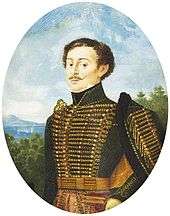Frog (fastening)
A frog fastener (also Chinese frog) is an ornamental braiding, consisting of a button and a loop, for fastening the front of a garment. The purpose of frog fasteners is to provide a decorative closure for a garment; frog fasteners are usual to garments of Asian design, such as a shirt or coat with a mandarin collar, which features frog fasteners at the shoulder and down the front of the garment. In the design of a garment, frogging is the use of braided, frog fasteners is a detail of the overall design of the garment.
.png)
Military uniforms

Frogs and frogging became an important decorative feature on military uniforms from the 17th–19th centuries. This was particularly evident for prestigious regiments, especially cavalry or hussars, and gave rise to the German term for frogging in general, 'Husarentressen'. These dolman jackets were tight-fitting and dominated by extensive frogging, often in luxurious materials such as gold, silver or brass metallic cording or brocades.
The frogging was usually far more than was necessary for fastening. In some cases it even became non-functional, with a concealed opening beneath it and the original jacket opening becoming a false detail. By the later 19th century, for lower grade uniforms down to postmen, telegraph boys and hotel pages, the frogging cordage would be retained as a decoration but there would be no corresponding toggle or opening with it.
Sewing
Many sewers make their own frogs because the results are customizable. Self-fabric can be used to create frogs that are the same color as the garment, though frogs are usually chosen to be a contrasting color to that of the garment.
Frogs are made by looping and interlocking the cording or fabric tube into the desired design, then securing the places where the cords touch by hand-sewing. The frog is then stitched onto a garment, usually by hand. When a fabric tube is used, the fabric is cut on bias. This allows the fabric tube to remain smooth and flex easily when bent into curves.
See also
References
| Wikimedia Commons has media related to Frogs (fasteners). |
- Singer 101 Sewing Secrets by The Editors of Cy DeCosse Incorporated, ISBN 0-86573-249-3.